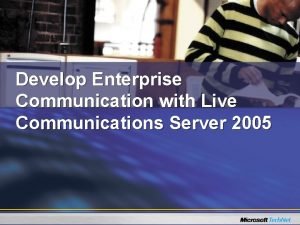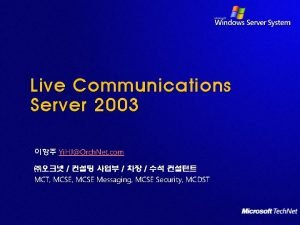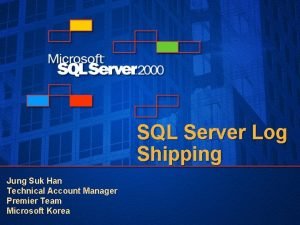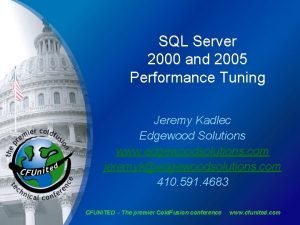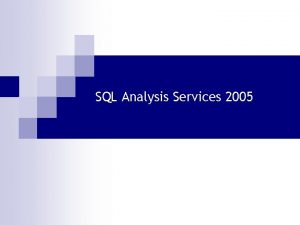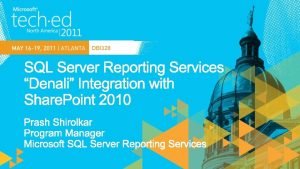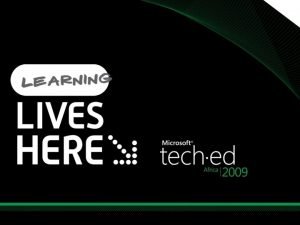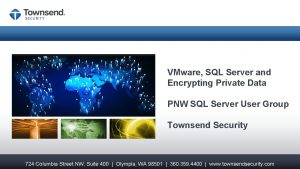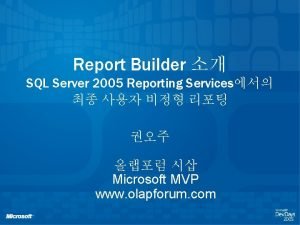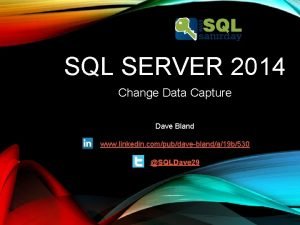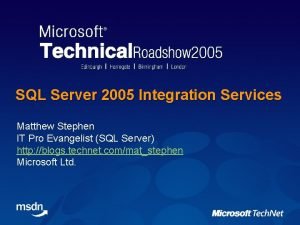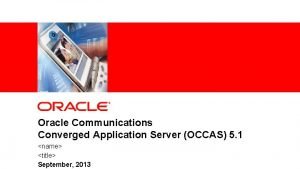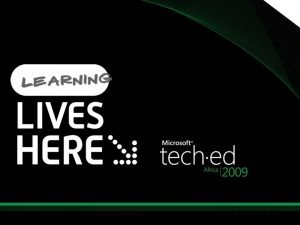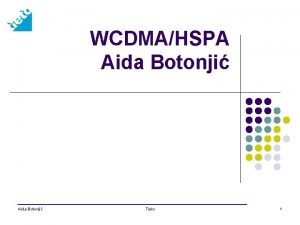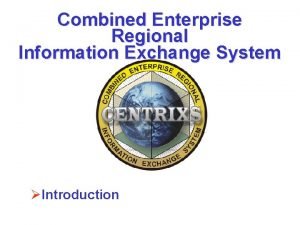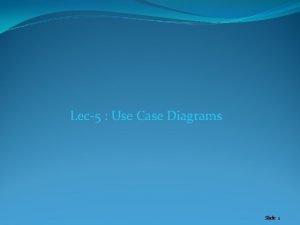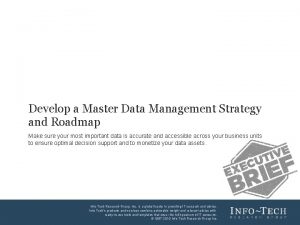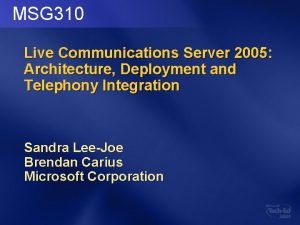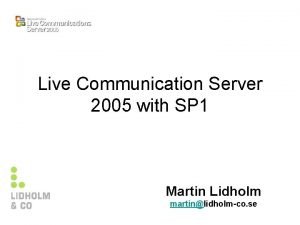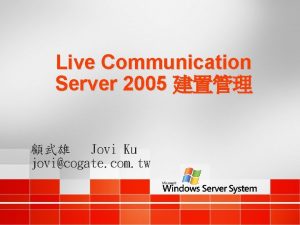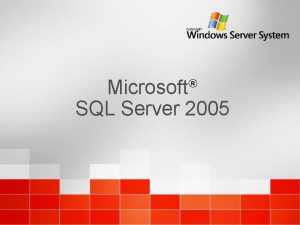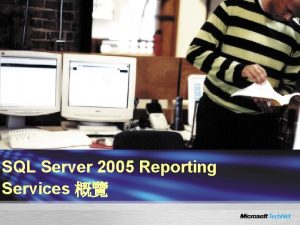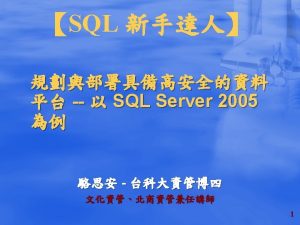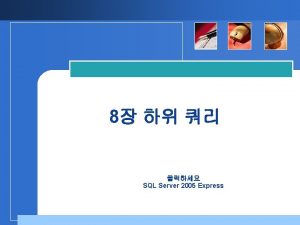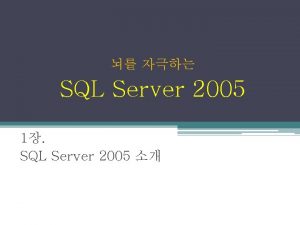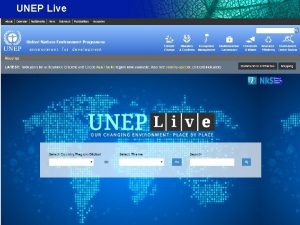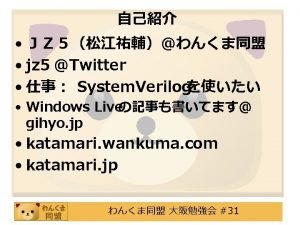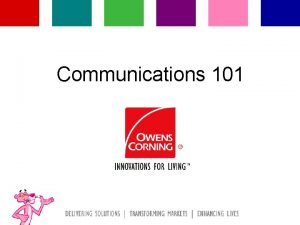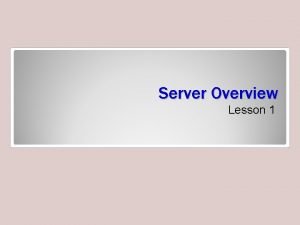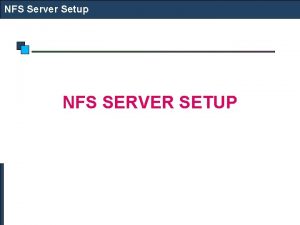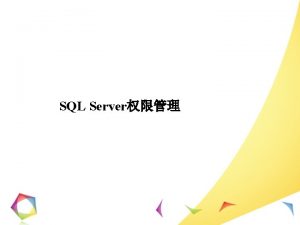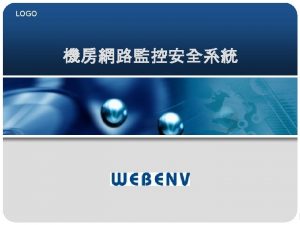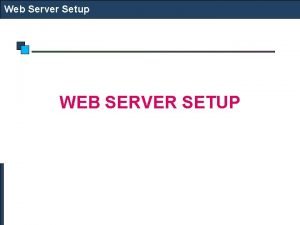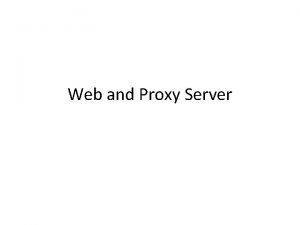Develop Enterprise Communication with Live Communications Server 2005














































- Slides: 46

Develop Enterprise Communication with Live Communications Server 2005

Prerequisite Knowledge • • Active Directory DNS PKI SQL Level 300

Agenda • • • Overview of Live Communications Server 2005 Differences in versions and editions Server Roles Preparing Active Directory Deploying and Managing Server Active Directory Topology Telephony Topology Remote Access Topology Federation Topology Remote Call Control Topology Archiving Topology

Live Communications Server 2005 Real-Time Collaboration Capabilities Integration Connect People Connect with other businesses Public IM networks Remote Users Find Subject Experts Share. Point Portal Microsoft Office Programs Telephony Windows Active Directory Exchange Server Reduce Cost Keep Data Safe Encryption and authentication Meet regulatory commitments Logging and Reporting Enable real-time decision making Reduce email storage Reduction in VPN/RAS Reduction in phone use

Overview • • Enterprise Instant Messaging Uses SIP (Session Initiation Protocol) Uses TLS (Transport Layer Security) Both SMB and Enterprise Solutions – LCS 2005 Standard Edition – LCS 2005 Enterprise Edition • Integrated with the Office System – Office 2003 – Share. Point – Live Meeting • Integrated with Active Directory

Live Communications Server 2005 Secure • • Windows AD Integration Transport Layer Security (TLS) connections Audio/Video privacy using RTP/LCP encryption Kerberos and NTLM for client authentication Manageable • • • Familiar Windows based management tools – WMI/MMC/MOM Manage users, servers, and global settings Group policy object support for a controlled rollout • • • SDK for Clients and Servers enable the building of compelling apps and solutions – creating a broad ecosystem Supporting a Store, Registrar, and a high-end Presence Engine Access to the SIP routing engine Connected • • Encrypted and managed enterprise to enterprise LCS Federation Managed connectivity to public IM clouds (MSN, AOL, Yahoo) IT administered “Safe User Lists” to control external connectivity Remote User Scenario – No VPN required Enterprise Grade • • Distributed, two-tiered architecture for scale and fault tolerance SQL Server storage for clustering and disaster recovery support Scalable deployment with new topologies “pool architecture” SAN support Extensible

Differences in Version

LCS 2003 • • • IM and presence Standard Edition Standards protocols (SIP and SIMPLE) Controlled SIP namespace Encryption Centralized management Integration with Active Directory Integration with Microsoft Office 2003 Archiving – logging of messages Customizable client using XML

LCS 2005 • • • Enterprise Edition High availability Remote user access Direct Federation Clearing house Active Directory topology support: – Resource forest – Central forest – Multi-tree forest

LCS 2005 SP 1 • • Enhanced Federation PIC – public IM connectivity Remote call control Address Book Service

Differences in Editions

Standard vs Enterprise Edition • Single computer configuration • MSDE • Single point of failure • Max 15, 000 active users • Multiple computer configuration • SQL server • No single point of failure • Max 125, 000 active users per pool • High availability • SQL clustering

Server Roles • Standard Edition Server • Director • Enterprise Pool – Hardware Load Balancer – Front-End Servers – SQL Back-End Server • Access Proxy • Branch Proxy • Archiving Service

Standard Edition Server • • Single computer installation Supports up to 15 k active users User’s data stored in MSDE Acts as a Director when no users are homed on it • Director proxies external SIP connections to the user’s server or pool

Enterprise pool • • • Multiple computer installation Supports up to 125 k active users Requires hardware load balancer User’s data stored in SQL Provides fault tolerance through redundant front-end servers Supports clustering of SQL back -end server

Access Proxy • Deployed in the network perimeter • Hardened against security attacks • Terminates TLS and MTLS connections • Controls Federation and Remote Access settings Internet Firewall Load balancer Firewall Corporate Network

A Example of LCS 2005 Topology

Preparing Active Directory 1. 2. 3. 4. Extending the Schema Running Forest Prep Running Domain Add Prep

Schema Extensions • Schema extension – 7 new classes – 22 new attributes • Causes Windows 2000 Global Catalogs (GC) to rebuild

Schema Extensions Objects: Attributes: • User • Contact • • • ms. RTCSIP-Primary. User. Address ms. RTCSIP-User. Enabled ms. RTCSIP-Target. Home. Server ms. RTCSIP-Originator. SID ms. RTCSIP-Primary. Home. Server ms. RTCSIP-Federation. Enabled (LCS 2005) ms. RTCSIP-Internet. Access. Enabled (LCS 2005) ms. RTCSIP-Archiving. Enabled (LCS 2005) ms. RTCSIP-Option. Flags (SP 1) ms. RTCSIP-Line. Server (SP 1) ms. RTCSIP-User. Extension

Schema Extensions Objects: Attributes: • Computer • • ms. RTCSIP-Enterprise. Server. Settings ms. RTCSIP-Enterprise. Services ms. RTCSIP-Pool. Address (LCS 2005) ms. RTCSIP-Server. Data

Schema Extensions Objects: Attributes: • Pool • • ms. RTCSIP-Pool. Display. Name (LCS 2005) ms. RTCSIP-Back. End. Server (LCS 2005) ms. RTCSIP-Pool. Type (LCS 2005) ms. RTCSIP-Pool. Version (SP 1) dns. Host. Name (LCS 2005) ms. RTCSIP-Pool. Data ms. RTCSIP-Pool. Service (LCS 2005) ms. RTCSIP-Front. End. Servers (LCS 2005)

Forest Prep • • • Run once per forest Run on the root domain Creates global settings

Domain Prep • Run on every domain hosting LCS • Creates new domain groups – – – RTCDomain. Server. Admins RTCDomain. User. Admins RTCHSDomain. Services • Sets permissions for these accounts at the root domain

Domain. Add Prep • • Cross domain administration Child domain access to Enterprise Objects Hosting users from other domains Run on – Root domain – User only domains • Gives permissions to the following groups – RTCDomain. Server. Admins to home users – RTCHSDomain. Services to read user attributes

Asking to Extend Schema

Piloting Live Communications Server Corporate Forest

Permissions • RTCDomain. User. Admins – Global Security Group – Must be a member to administer users across domains • RTCDomain. Server. Admins – Global Security Group – Used to administer servers across domains • RTCHSDomain. Services – Global Security Group – Must be a member to install and activate servers

demonstration Deploying and Managing Live Communications Server 2005

Management Capabilities MMC / WMI Active Directory Users and Computer snap-in Admin Tools Performance monitoring Wizard based tasks WMI interface for scripting SQL Highly available Meet regulatory commitments Logging and Reporting Active Directory Integration by extending AD Performs authentication Performs authorization MOM Enable real-time monitoring Management pack available

Live Communications Server 2005 Administration – Resource View Server and Server Pool Management Task pane List of Technical Documentation

Live Communications Server 2005 Administration – Performance View

Active Directory Topology • Single Forest – Multiple Domains – Multi-Tree Forest • Multiple Forests – Resource Forest – Central Forest

Resource Forest Disabled users Resource Forest

Central Forest MIIS contacts Central Forest

Telephony Topology

SIP to PSTN SIP MTLS PSTN Static route PBX SIP/PSTN gateway SIP Proxy

Remote Access Topology

Remote User Firewall: port 443 or 5061 DMZ Director Pool TLS MTLS (NTLM challenge) Access Proxy AD

Federation Topology • Direct • Enhanced • Public Instant Messaging Connectivity • Clearing house

Direct Federation Pool MTLS AD Enterprise A Access Proxy MTLS DNS Pool MTLS AD Enterprise B

Enhanced Federation Go from this in LCS 2005…to this with SP 1!

Enhanced Federation Supplier Contoso DNS MTLS Joe Bob 1. Is Supplier. com in the block list? NO 2. Look-up SIPFederation. TLS. _TCP. supplier. com – Verify that AP name matches domain name 3. Establish MTLS connection and verify certificate SN

Public Instant Messaging Connectivity With MSN, AOL, Yahoo Enterprise A LCS 2005 Access Proxy LCS 2005 LCS Client • • LCS Client A top customer-requested scenario Brings together corporate IM and public IM No 3 rd party gateways/software required One desktop client LCS 2005 Access Proxy SIP Proxy LCS 2005 Access Proxy

Clearing house F Contoso D Routing table on the AP: Domain Default route: Block: Next hop AP. Clear D. com G. com E Clearing house

Summary • Considerations before deploying – Active Directory infrastructure – Geographic distribution of users – Network bandwidth between geographies • Feature requirements • Up-time
 Live communications server
Live communications server Live communications server 2003
Live communications server 2003 How to monitor log shipping in sql server 2005
How to monitor log shipping in sql server 2005 Sql server 2005 performance
Sql server 2005 performance Microsoft sql server 2005 analysis services
Microsoft sql server 2005 analysis services Sql server 2005 express management studio
Sql server 2005 express management studio Sql server 2005 sp
Sql server 2005 sp Ms sql 2008 dts
Ms sql 2008 dts Random number generator
Random number generator Reporting services 2005
Reporting services 2005 Sys.sp_cdc_add_job
Sys.sp_cdc_add_job Ssis sql server 2005
Ssis sql server 2005 Visual studio 2005 team
Visual studio 2005 team Occas oracle
Occas oracle Office communications server 7
Office communications server 7 Quizletlive
Quizletlive Live happy live healthy
Live happy live healthy Sql server enterprise master data management
Sql server enterprise master data management Tieto teis
Tieto teis Tieto enterprise integration server
Tieto enterprise integration server Centrixs
Centrixs Putting the enterprise into the enterprise system
Putting the enterprise into the enterprise system Enterprise
Enterprise Why did a stale- mate develop on the western front?
Why did a stale- mate develop on the western front? Why did a stale- mate develop on the western front?
Why did a stale- mate develop on the western front? Competency based job descriptions
Competency based job descriptions Igneous rock
Igneous rock Soft skills intrapersonal
Soft skills intrapersonal Social factors
Social factors Develop schedule in project management
Develop schedule in project management Use case diagram for alarm clock
Use case diagram for alarm clock Develop discrepancy example
Develop discrepancy example Develop discrepancy example
Develop discrepancy example Hamlets dull revenge
Hamlets dull revenge History of guidance and counselling in the philippines
History of guidance and counselling in the philippines Transactive goals develop:
Transactive goals develop: How to develop a beverage product
How to develop a beverage product Master data management roadmap
Master data management roadmap How do we develop our self concept
How do we develop our self concept Self concept and lifestyle
Self concept and lifestyle Approaches to develop physical factors
Approaches to develop physical factors Approaches for mental factor
Approaches for mental factor Approaches to develop emotional factors
Approaches to develop emotional factors Approaches to develop emotional factors
Approaches to develop emotional factors Inputs to develop project charter
Inputs to develop project charter The way sounds are woven together
The way sounds are woven together Mcdp-1 states that trust
Mcdp-1 states that trust
